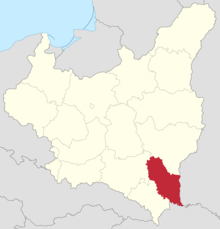| Tarnopol Voivodeship Województwo tarnopolskie | |||||||||
|---|---|---|---|---|---|---|---|---|---|
| Voivodeship of Poland | |||||||||
| 1920–1939 | |||||||||
 Tarnopol Voivodeship (red) on the map of Second Polish Republic[1] | |||||||||
| Capital | Tarnopol | ||||||||
| Area | |||||||||
• 1921 | 16,533 km2 (6,383 sq mi) | ||||||||
| Population | |||||||||
• 1921 | 1,428,520 | ||||||||
• 1931 | 1,600,406 | ||||||||
| Government | |||||||||
| • Type | Voivodeship | ||||||||
| Voivodes | |||||||||
• 1921–1923 | Karol Olpiński | ||||||||
• 1937–1939 | Tomasz Malicki | ||||||||
| Historical era | Interwar period | ||||||||
• Established | 23 December 1920 | ||||||||
| 17 September 1939 | |||||||||
| Political subdivisions | 17 powiats, 35 towns | ||||||||
| |||||||||
| Today part of | Ukraine | ||||||||
Tarnopol Voivodeship (Polish: Województwo tarnopolskie; Ukrainian: Тернопільське воєводство, romanized: Ternopilske voievodstvo) was an administrative region of interwar Poland (1918–1939), created on 23 December 1920, with an area of 16,500 km2 and provincial capital in Tarnopol (now Ternopil, Ukraine). The voivodeship was divided into 17 districts (powiaty). At the end of World War II, at the insistence of Joseph Stalin during the Tehran Conference of 1943 without official Polish representation whatsoever, the borders of Poland were redrawn by the Allies. The Polish population was forcibly resettled after the defeat of Nazi Germany and the Tarnopol Voivodeship was incorporated into the Ukrainian SSR of the Soviet Union. Since 1991, most of the region is located in the Ternopil Oblast in sovereign Ukraine.
